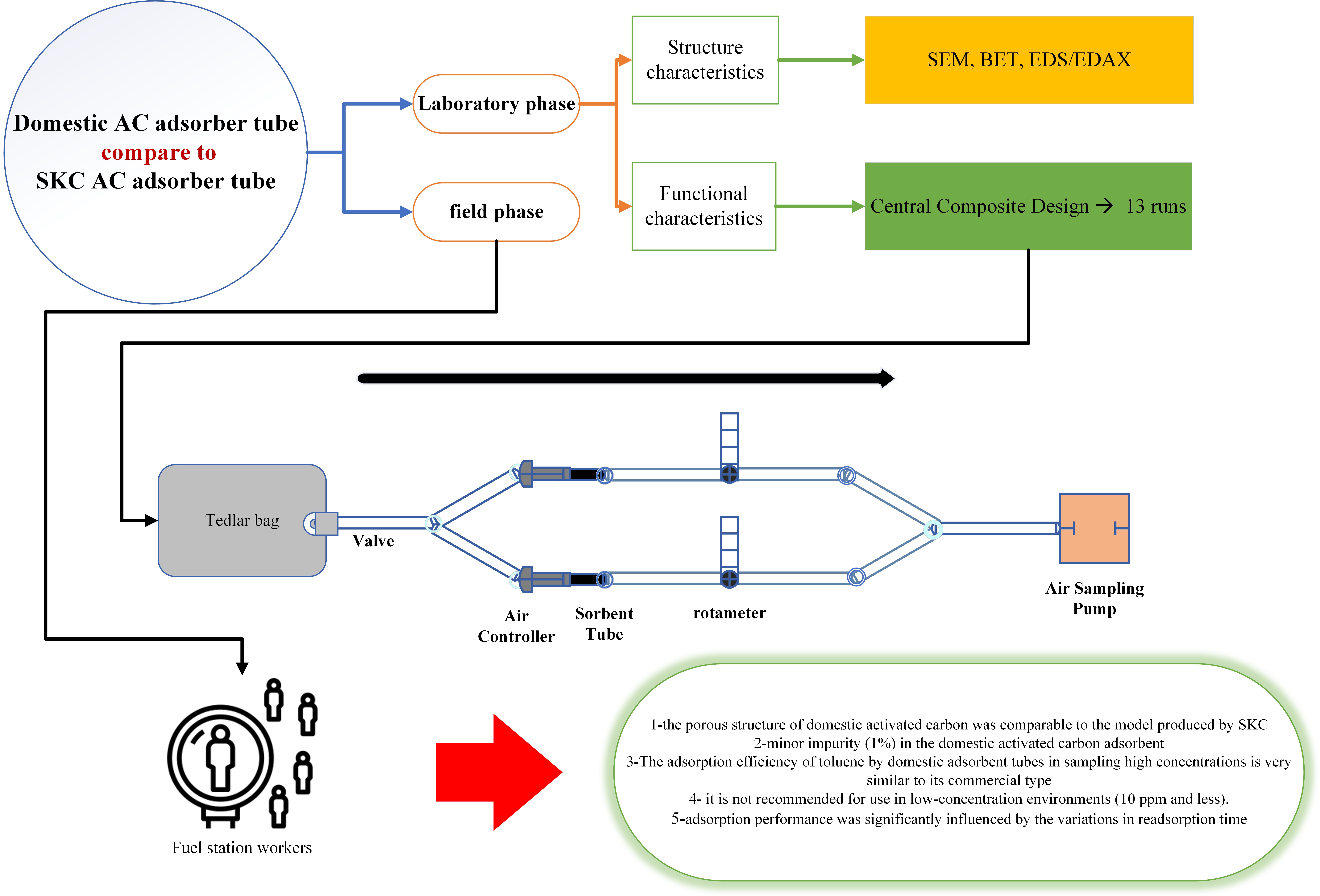Volume 13, Issue 4 (12-2023)
J Health Saf Work 2023, 13(4): 838-855 |
Back to browse issues page
Download citation:
BibTeX | RIS | EndNote | Medlars | ProCite | Reference Manager | RefWorks
Send citation to:



BibTeX | RIS | EndNote | Medlars | ProCite | Reference Manager | RefWorks
Send citation to:
Alinia Ahandani M, Kalantary S, Khadem M, Jafari F, Azam K, Golbabaei F. Assessment and Validation of Domestically Made Activated Carbon Sorbent Tubes for Sampling air Pollutants. J Health Saf Work 2023; 13 (4) :838-855
URL: http://jhsw.tums.ac.ir/article-1-6912-en.html
URL: http://jhsw.tums.ac.ir/article-1-6912-en.html
Mahdi Alinia Ahandani1 
 , Saba Kalantary1
, Saba Kalantary1 
 , Monireh Khadem1
, Monireh Khadem1 
 , Fatemeh Jafari1
, Fatemeh Jafari1 
 , Kamal Azam2
, Kamal Azam2 
 , Farideh Golbabaei *
, Farideh Golbabaei * 
 3
3

 , Saba Kalantary1
, Saba Kalantary1 
 , Monireh Khadem1
, Monireh Khadem1 
 , Fatemeh Jafari1
, Fatemeh Jafari1 
 , Kamal Azam2
, Kamal Azam2 
 , Farideh Golbabaei *
, Farideh Golbabaei * 
 3
3
1- Department of Occupational Health Engineering, School of health, Tehran University of Medical Sciences, Tehran, Iran
2- Department of Epidemiology and Biostatistics, School of Public Health, Tehran University of Medical Sciences,Tehran, Iran
3- Department of Occupational Health Engineering, School of health, Tehran University of Medical Sciences, Tehran, Iran ,fgolbabaei@tums.ac.ir
2- Department of Epidemiology and Biostatistics, School of Public Health, Tehran University of Medical Sciences,Tehran, Iran
3- Department of Occupational Health Engineering, School of health, Tehran University of Medical Sciences, Tehran, Iran ,
Abstract: (797 Views)
Introduction: VOCs are harmful air pollutants that must be detected, monitored and eliminated. Adsorber tubes are standard tools for this task, specifically activated carbon tubes with high adsorption and selectivity. This research aims to compare the structural and functional characteristics of domestically produced activated carbon tubes with the conventional commercial ones for sampling toluene, a volatile organic compound.
Material and Methods: The characteristics of each adsorbent, such as structure, morphology, porosity, and element composition, were examined by SEM photography, BET testing, and EDAX analysis. The central composite design (CCD) method was employed to investigate the adsorption properties of the adsorbents. The input concentration and readsorption time of the samples were the variables considered in this study. Additionally, a field phase of personal air sampling was performed to evaluate the effectiveness of adsorbent tubes.
Results: SEM and BET analyses indicated that the porous structure of domestic activated carbon was comparable to the model produced by SKC. EDAX analysis detected a minor impurity (1%) in the domestic activated carbon adsorbent. The adsorption performance was significantly influenced by the variations in readsorption time and pollutant input concentration. The accuracy and precision of the performance of the domestic adsorbent tube were obtained as 90.77% and 91.76%. The field phase results demonstrated that the amount of pollutant adsorbed in the SKC-activated charcoal adsorber did not differ significantly during 0 to 30 days. However, the domestic adsorber showed a significant difference in the same period. The overall performance of the two adsorbers did not exhibit a significant difference between 0 and 30 days.
Conclusion: Despite minor structural differences, the adsorption efficiency of toluene by domestic adsorbent tubes in sampling high concentrations is very similar to its commercial type. However, it is not recommended for use in low-concentration environments (10 ppm and less).
Material and Methods: The characteristics of each adsorbent, such as structure, morphology, porosity, and element composition, were examined by SEM photography, BET testing, and EDAX analysis. The central composite design (CCD) method was employed to investigate the adsorption properties of the adsorbents. The input concentration and readsorption time of the samples were the variables considered in this study. Additionally, a field phase of personal air sampling was performed to evaluate the effectiveness of adsorbent tubes.
Results: SEM and BET analyses indicated that the porous structure of domestic activated carbon was comparable to the model produced by SKC. EDAX analysis detected a minor impurity (1%) in the domestic activated carbon adsorbent. The adsorption performance was significantly influenced by the variations in readsorption time and pollutant input concentration. The accuracy and precision of the performance of the domestic adsorbent tube were obtained as 90.77% and 91.76%. The field phase results demonstrated that the amount of pollutant adsorbed in the SKC-activated charcoal adsorber did not differ significantly during 0 to 30 days. However, the domestic adsorber showed a significant difference in the same period. The overall performance of the two adsorbers did not exhibit a significant difference between 0 and 30 days.
Conclusion: Despite minor structural differences, the adsorption efficiency of toluene by domestic adsorbent tubes in sampling high concentrations is very similar to its commercial type. However, it is not recommended for use in low-concentration environments (10 ppm and less).
Type of Study: Research |
Received: 2024/01/1 | Accepted: 2023/12/31 | Published: 2023/12/31
Received: 2024/01/1 | Accepted: 2023/12/31 | Published: 2023/12/31
Send email to the article author
| Rights and permissions | |
 |
This work is licensed under a Creative Commons Attribution-NonCommercial 4.0 International License. |




